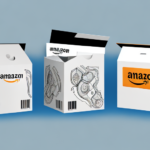Dropshipping vs Amazon FBA: Which Is the Better Option for Your Business?
Deciding between dropshipping and Amazon FBA is a crucial step for entrepreneurs starting an online retail business. Both models have distinct advantages and challenges that can significantly impact your business's success. This comprehensive guide delves into the key differences, benefits, and drawbacks of each option to help you make an informed decision.
Understanding the Basics: What Are Dropshipping and Amazon FBA?
Before evaluating the pros and cons, it's essential to grasp the fundamentals of dropshipping and Amazon FBA.
What is Dropshipping?
Dropshipping is a business model that allows you to sell products without holding any inventory. When a customer places an order, the supplier ships the product directly to the customer on your behalf. This eliminates the need for inventory management, reducing your overhead costs significantly.
According to a recent industry report, the global dropshipping market is projected to reach $557.9 billion by 2025, highlighting its growing popularity.
What is Amazon FBA?
Amazon FBA (Fulfillment by Amazon) is a service that allows you to store your products in Amazon's fulfillment centers. Amazon handles storage, packing, shipping, and customer service, including returns. While this means you must invest in inventory upfront, it leverages Amazon's robust logistics network.
As of 2023, over 1.9 million small businesses use Amazon FBA to scale their operations and reach a broader customer base.
Pros and Cons of Dropshipping: Is It Right for Your Business?
Dropshipping offers several advantages that make it an attractive option for new entrepreneurs:
- Lower Upfront Costs: No need to purchase inventory, reducing initial investment.
- Lower Overhead Costs: No warehousing or shipping expenses.
- Flexible Business Model: Easily test and switch products without significant financial risk.
- Global Reach: Operate from anywhere with an internet connection.
However, dropshipping also comes with its challenges:
- Lower Profit Margins: Higher cost per unit due to lack of bulk purchasing.
- Less Control Over Customer Experience: Dependence on suppliers for shipping and service quality.
- Higher Competition: Increased competition can drive prices down, making differentiation difficult.
Additionally, finding reliable suppliers is critical. Poor supplier performance can lead to delays, damaged products, and negative customer reviews. Ensuring you partner with reputable suppliers is essential for maintaining quality and customer satisfaction.
Pros and Cons of Amazon FBA: Is It a Good Fit for Your Business?
Amazon FBA presents its unique set of benefits:
- Access to Amazon’s Customer Base: Tap into millions of potential customers worldwide.
- Prime Eligibility: Increase sales with products eligible for Amazon Prime's free two-day shipping.
- Lower Shipping Costs: Benefit from Amazon's negotiated shipping rates.
- Less Time on Logistics: Amazon manages packing, shipping, and customer service, allowing you to focus on other business areas.
- Improved Product Rankings: FBA products often rank higher in Amazon search results, boosting visibility and sales.
Despite these advantages, Amazon FBA has its drawbacks:
- Higher Upfront Costs: Significant investment required for purchasing and storing inventory.
- Less Flexibility: Changing product offerings can be costly once inventory is sent to Amazon's warehouses.
- Reduced Control Over Customer Experience: Reliance on Amazon for customer service can impact your brand's reputation.
Moreover, Amazon FBA facilitates international expansion by managing international shipping and customs, making it easier to reach a global audience.
Comparison of Dropshipping and Amazon FBA: Which Offers Better Profit Margins?
Profit margins differ significantly between the two models. Dropshipping generally offers lower profit margins due to higher per-unit costs. In contrast, Amazon FBA can provide higher margins over time, especially when leveraging bulk purchasing and Amazon’s logistical efficiencies. According to ShipScience, businesses using FBA can see profit margins ranging from 15% to 30%, whereas dropshipping margins typically range from 10% to 20%.
Fulfillment Options: How Does Dropshipping Compare to Amazon FBA?
Fulfillment strategies vary greatly between dropshipping and Amazon FBA:
- Dropshipping: Suppliers handle all shipping and handling, allowing you to focus solely on marketing and sales.
- Amazon FBA: Amazon manages storage, packing, shipping, and customer service, streamlining the fulfillment process.
Choosing the right fulfillment method depends on your business priorities, whether it’s minimizing upfront costs or leveraging Amazon’s logistics network for scalability.
Customer Service: Which Is Better for Your Customers – Dropshipping or Amazon FBA?
Customer service quality can impact your business's reputation:
- Dropshipping: Limited control over customer service as suppliers handle responses and issue resolution.
- Amazon FBA: Amazon provides robust customer service, including handling returns and inquiries, often leading to higher customer satisfaction.
Choosing Amazon FBA can enhance customer trust and satisfaction due to Amazon’s established reputation for excellent service.
Product Catalogue: Can You Sell the Same Products with Both Dropshipping and Amazon FBA?
The flexibility of your product catalogue depends on your suppliers:
- Dropshipping: Offers a wide variety of products from multiple suppliers, allowing for extensive product testing and niche targeting.
- Amazon FBA: Product selection may be limited by Amazon's policies and supplier agreements, but ensures higher quality and faster shipping.
Researching and selecting suppliers that align with your business goals is crucial regardless of the fulfillment model.
Shipping Times and Costs: Comparing Dropshipping and Amazon FBA
Shipping efficiency and costs are critical factors in customer satisfaction:
- Dropshipping: Typically offers faster initial shipping as products go directly from suppliers to customers, but can be inconsistent based on supplier location.
- Amazon FBA: While shipping times are reliable and optimized for speed, especially for Prime members, costs may vary based on storage and shipping volume.
Amazon FBA’s ability to negotiate lower shipping rates can lead to cost savings over time, especially for high-volume sellers.
Inventory Management: Which Option Is Easier to Manage – Dropshipping or Amazon FBA?
Inventory management differs significantly between the two models:
- Dropshipping: No need to manage or store inventory, reducing complexity and overhead.
- Amazon FBA: Requires purchasing and storing inventory, necessitating careful inventory planning and management.
Dropshipping offers simplicity in inventory management, while Amazon FBA provides scalability at the cost of increased complexity.
Investment Requirements: How Much Money Do You Need to Start with Dropshipping or Amazon FBA?
Your initial investment requirements vary between the two models:
- Dropshipping: Requires minimal upfront investment, primarily for website setup, marketing, and possibly supplier fees.
- Amazon FBA: Demands a higher initial investment for purchasing inventory, shipping to Amazon warehouses, and storage fees.
Evaluate your budget and financial capabilities to determine which model aligns with your startup capital.
Marketing Strategies: Which Option Offers More Opportunities for Marketing and Promotion?
Both models offer unique marketing opportunities:
- Dropshipping: Greater flexibility in product offerings allows targeting niche markets and experimenting with various marketing channels.
- Amazon FBA: Benefits from Amazon’s built-in customer base and advertising tools, enhancing product visibility and reach.
Effective use of Amazon’s marketing tools, such as Sponsored Products, can drive significant traffic and sales for FBA sellers.
Branding Considerations: How Does Dropshipping Compare to Amazon FBA in Terms of Building Your Brand Identity?
Brand identity plays a crucial role in long-term business success:
- Dropshipping: Offers greater control over branding, packaging, and customer experience, enabling the creation of a unique brand identity.
- Amazon FBA: Limited branding opportunities as products are closely associated with the Amazon platform, potentially diluting brand uniqueness.
If building a strong, recognizable brand is a priority, dropshipping provides more flexibility to differentiate your brand.
Legal Compliance: Understanding the Legal Requirements for Both Dropshipping and Amazon FBA
Both business models come with distinct legal considerations:
- Dropshipping: Requires ensuring suppliers comply with product standards and regulations. It’s essential to verify the legality of products in different regions.
- Amazon FBA: Must adhere to Amazon’s policies, tax regulations, and international shipping laws. Proper documentation and compliance are critical to avoid penalties.
Consulting with a legal professional can help navigate the complexities and ensure full compliance with all applicable laws and regulations.
Success Stories: Real-Life Examples of Businesses Succeeding with Both Dropshipping and Amazon FBA
Examining successful businesses provides valuable insights:
- Fashion Nova: A standout success using dropshipping to rapidly scale by offering trendy apparel without significant inventory costs.
- Anchor: Leveraging Amazon FBA to distribute high-quality headphones globally, benefiting from Amazon’s logistics and customer service excellence.
These examples highlight how different models can be effectively utilized based on business goals and market strategies.
Conclusion and Final Thoughts: Which Option Should You Choose for Your Business?
The decision between dropshipping and Amazon FBA hinges on your specific business needs, resources, and long-term goals. Dropshipping is ideal for those with limited startup capital who seek flexibility and lower overhead costs. In contrast, Amazon FBA suits businesses ready to invest in inventory for higher profit margins and leveraging Amazon’s extensive logistics network.
Carefully consider the pros and cons outlined above, assess your financial situation, and align your choice with your business objectives to ensure sustainable growth and success.




















